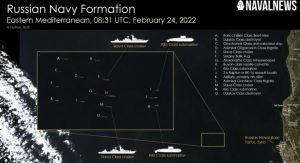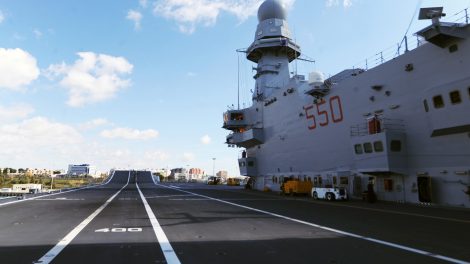The Russian fleet in the Mediterranean Sea has assumed a tight formation near its naval base at Tartus, off the Syrian coast. The manoeuvre could be aimed at providing long-range support to the Russian Navy’s operations in the Black Sea, aiding the southern invasion of Ukraine. It could also deter a possible involvement of NATO naval forces in the Black Sea.
The Russian formation
The fleet was spotted by ESA’s Sentinel 2 satellites on Thursday, showing the sixteen ships of the Russian force a few miles off the Syrian coast. The formation is only 1.5 km wide and just under 3 km long. This means that the ships are in sight of each other, an unusual and very compact formation.
Thanks to the support of Russian bases in Syria, the naval group enjoys full air cover. This formation is mainly used during exercises, and not in a potential conflict situation, where it’s preferrable to disperse their units over a larger area. Satellites also spotted two submarines on the surface. That, too, is an oddity, as they effectively renounced their main asset: secrecy.

Moscow’s ships in the Med
Essentially all of Russia’s ships in the Mediterranean basin were involved in that manoeuvre, including the two powerful Slava-class cruisers, Marshal Ustinov and Varyag. Designed primarily for anti-ship combat, each 12,000 ton vessel is armed with sixteen P-1000 Vulkan supersonic missiles and 64 S-300F Rif anti-aircraft missiles.
Alongside these are two Udaloy class anti-submarine destroyers, including the Admiral Tributs, one of the first units to reach the Med in recent days. Moreover, there are escort units such as the frigate Admiral Grigorovich and the corvettes Dmitriy Rogachev and Vyshniy Volochek, each equipped with Kalibr cruise missile batteries, and a supply ship, the tanker Boris Butoma.
The Mediterranean fleet also counts six amphibious units, five of the Ropucha class (Ropucha, Korolev, Minsk and Kaliningrad, Olenegorskiy Gornyak and Georgiy Pobedonosets), and a larger Ivan Gren class (Pyotr Morgunov) along with three diesel-electric submarines, Stary Oskol, Krasnodar and Novorossiysk, two of which are visible in the satellite photos.
Possible targets: Ukraine…
Normally the different units are expected to operate in separate groups. In particular, the Kilo class submarines are used to conduct long-range patrols, thanks to their capacity for secrecy. It is not a foregone conclusion that the formation will separate at a later date.
One of the possible objectives of the group could be to reach the Black Sea to directly support the invasion of Ukraine.In fact, the six amphibious ships allow the group to project about two thousand soldiers and about fifty battle tanks onto the southern Ukrainian coasts.
To do this, however, the fleet would have to be able to pass through the Dardanelles Strait through Turkish waters (a NATO member), with Kiyv expressly requesting Ankara not to allow the transit. It was erroneously reported on Saturday that Turkey had blocked off the strait.
… or anti-NATO operations
The second hypothesis entails deterring NATO fleets from reaching the Black Sea and potentially interfering with operations in Ukraine.
In fact, the Atlantic Alliance’s “Dynamic Manta” exercise is active in the Med and counts eleven ships, four submarines and several combat aircraft from nine allied countries (United States, Italy, Canada, France, Germany, Greece, Spain, Turkey and the United Kingdom).
All units are under the command of Rear Admiral Mauro Panebianco, commander of NATO’s Second Permanent Naval Group. The Navy is taking part in the exercise with the frigates Margottini and Carabiniere, and the submarine Salvatore Todaro, as well as air and logistic assets.




